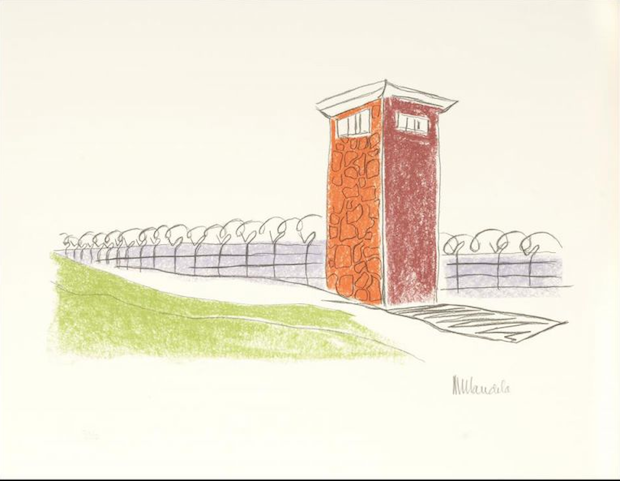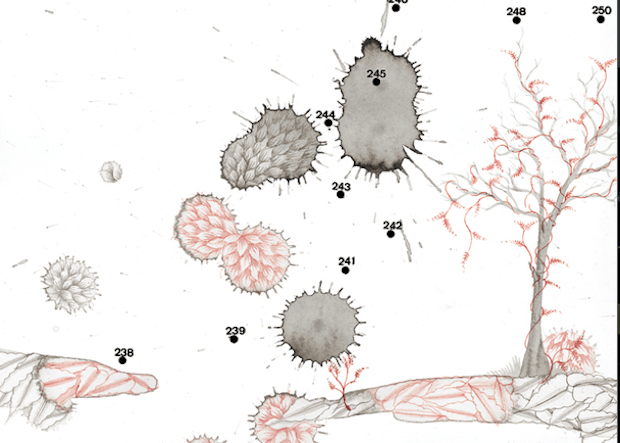Political Art Today
Contemporary Art meets Reality. How powerful is political art?
Gilbert & George - Image: RAT / London Pictures - AVAILABLE IN OUR SHOP

Today, it is rare for Western contemporary artists to turn to bold or even drastic methods to discuss or denounce political and social problems. There is no shortage of criticism, often with an ironic overtone. The themes however generally revolve much more around the I, the private and the negative consequences our affluent society has on man and environment. However, the situation looks different in other parts of the world where there is no freedom and political stability. A few thoughts on the subject of political art.
Swiss artist Thomas Hirschhorn is a major exception from that rule. Not only does he expose the observer to harrowing photos of suffering and injured people in crisis and war areas all around the world. The artist is also committed to social projects, such as the “Gramski Monument”, a neighbourhood project that criticizes the lack of cultural activities and the disinterest of the people responsible in deprived areas such as the New York district Bronx. Being overly explicit is considered outdated, idealistic and naïve. A frequently cited and rather derogatory quote goes: People who have visions should go see their doctor.
The situation is entirely different in other parts of the world, where the problems are different and concern – if not mere survival – a free and peaceful life. This is not only the case for Arabian artists, who find themselves in the spotlight due to the overthrows of the Arabian spring. It is also true for Latin-American artists who fight with artistic means against the corruption and drug wars in their countries. And it is also the case for artists who live in seemingly or superficially stable states whose governments react rather irritably when someone scratches that surface. The arrests of Pussy Riot in Russia and Ai Weiwei in China demonstrated to the whole world what rulers disapprove of and how they use their influence to muzzle defiant artists. Criticism, even if it is overly explicit, is still a valid artistic means to interpret our world and make things visible. It creates awareness, which is the first important step. Art cannot make the world better, only people can do that. Yet maybe it was art that shook them up in the first place.
Erik Bulatov - Image: La voûte - La pente (2001) - AVAILABLE IN OUR SHOP

The shapes and contents of artistic criticism are as versatile as the conflicts and problems of the world, respectively as individual as the artists creating it. Eric Bulatov is an artist whose subtle criticism only becomes apparent on second glance. The artist has been dealing with the former Soviet Union’s official aesthetic for decades. In his paintings and drawings he creates photorealistic landscapes, which he combines with words and sentences, similar to Ed Ruscha. These messages are always in Russian, Bulatov’s mother tongue, even though he left Russia in 1991 and has been living in Paris for over 20 years. Even though he worked under hampered conditions, Bulatov did not leave Soviet Russia and became one of the most important non-official artists during the Soviet era.
Read more about Erik Bulatov here. Click here for available artworks by the Russian artist in our shop.
Nelson Mandela: Mandela's Walk - AVAILABLE IN OUR SHOP

Not an artist in the usual sense of the word, but an eminent political figure is the former South-African president Nelson Mandela. His courageous battle against apartheid was punished with several long imprisonments, which could not break his strong will. After his release from prison, Mandela became a successful politician and continues to be one of South Africa’s heroes. His drawings are journeys of reminiscence to the troublesome time in prison and an urge for peace and justice.
Read more about Nelson Mandela here. Click here for available artworks by Mandela in our shop.
Imran Qureshi - Image: Ausschnitt aus dem Buch "Side by Side" - AVAILABLE IN OUR SHOP

Suffering and hope are also the central themes in Imran Qureshi’s works. The Pakistani artist is considered the reviver of traditionally Islamic miniature painting, a technique he transfers into current times by combining it with contemporary topics. Qureshi has just been in the art world’s centre of attention when he showed his work on the rooftop garden of the Metropolitan Museum of Art. His characteristic, painted red flower networks covered the entire ground of the garden. Only at second glance do the flowers reveal their disturbing quality, they seem to grow from puddles of blood covering the ground. With his work, Qureshi references an image commonplace in his home country and contrasts it with the hopeful flowers.
Read more about Imran Qureshi here. Click here for available artworks by the Pakistani artist in our shop.
Elmgreen & Dragset: Portrait of the Artist as a Young (homosexual) Man - AVAILABLE IN OUR SHOP

The artist duo Elmgreen & Dragset have a much more Western view of the world and thus a different focus. With their humorous and ironic art, the Danish and Norwegian artists point their finger on the weak points and lies of consumer culture. Their infamous Prada store next to a dusty road in the middle of the Texan desert has caused quite a furore. Sylvie Fleury is another artist combining criticism of consumerism and humour. She calls her work Appropriation Art, taking consumer goods out of their usual context and putting them into new ones. She puts a golden shopping trolley onto a platform and thus elevates it and everything it symbolised into new spheres.
Read more about Elmgreen & Dragset here. Click here for available artworks by the artist duo in our shop.
Read more about Sylvie Fleury here. Click here for available artworks by the Swiss artist in our shop.
Sylvie Fleury: Gucci Handcufffs (2001-02) - AVAILABLE IN OUR SHOP

The artist duo Gilbert and George focuses on various socially relevant topics such as violence, racism and religion. They dealt with the medial excesses of the British Yellow Press in their large series “London Pictures”. In this work, they compiled the sensational and blatant covers of tabloids according to key words. Headlines such as “Cleaner killed in Street Attack”, “Mother and Son killed in Bath” and “Swans killed and eaten” form a shocking image together with many more similar titles. The work is a significant message on medial war and bored, sensation-seeking readers. Font is also a central motif in Jenny Holzer’s work – the artist mostly uses it as LED light art or to illuminate buildings. Her messages and quotes inspire reflection and are mostly critical of society in different areas. The American installation artist aims for the observer to shortly pause and rest in order to read and understand her message.
Read more about Gilbert & George here. Click here for available artworks by the British artist duo in our shop.
Gilbert & George - Image: Ban Religion (2007) - AVAILABLE IN OUR SHOP

There are many more socially and politically critical artists. The French-Peruvian artist Jota Castro draws attention to the suffering of illegal immigrants and boat people, Spanish artist Santiago Sierra deals with low-wage labour and human exploitation in his often poignant performances. As prominent female artists, Mona Hatoum and Shirin Neshat are committed to issues of women and intercultural tolerance. Paul McCarthy poignantly comments on the social decay of his home country USA. It is not least the constantly growing and increasingly popular Street-Art-Scene that takes art right to where many problems are solved with police violence and tear gas – to the streets. Each country and each region has its individual focus, and the statements and caricatures are far from popular with the rulers. Political art as protest and resistance – the artists, who often work illegally, are always also political activists.
Interesting publication on art and politics:
Art & Agenda. Political Art and Activism (Gestalten, 2011)
Exhibitions:
Street-Art Brazil. Schirn-Kunsthalle Frankfurt a.M., until 27 October 2013
Santiago Sierra. Sculpture, Photography, Film. Falckenberg Collection, Hamburg-Harburg, until 12 January 2013







